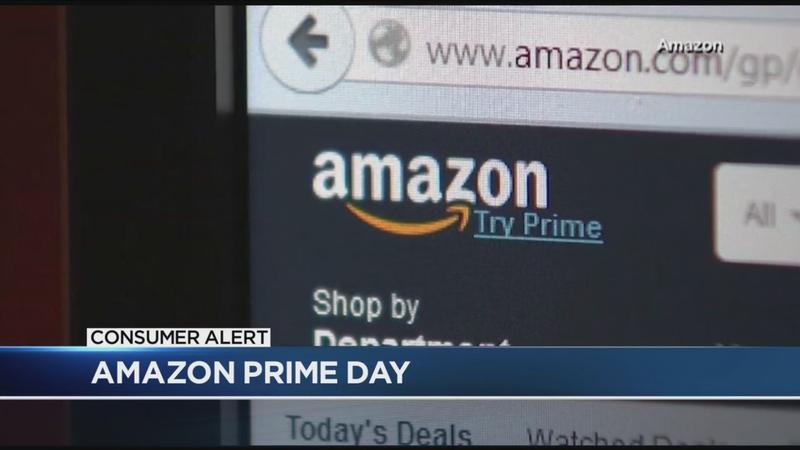Consumer Alert: How to get the most bang for your buck on Amazon Prime Day
[anvplayer video=”5120407″ station=”998131″]
ROCHESTER, N.Y. (WHEC) – The News10 NBC family has something to celebrate! Our family is growing! Many of our viewers likely spotted the announcement on Twitter Monday!
Our own answer man, Brennan Somers and his beautiful wife Stephanie Robusto shared the news on the 4th of July and featured the baby’s first selfie, the sonogram! Their newest little firecracker is expected in December. So in celebration, Wednesday’s consumer alert looked at how parents can get the most bang for their buck during Amazon Prime Day!
Prime Day is actually two days, July 12 and 13. The online shopping behemoth promises the deals will be Black Friday worthy. That’s especially important for expectant parents. Let’s face it. Babies are expensive. Experts say Prime Day is the time to stock up on both pricey items as well as those items you buy in bulk.
"Normally those bigger ticket items like cribs or strollers or car seats, those are items where you’ll save the most money,” said Haley Jena an editor with What to Expect, a pregnancy resource website. “And Prime Day is a great time to stock up on everyday essentials like diapers or baby wipes. Those we often see discounts on too and it’s an easy way to just—if you know that you’re going to use them, you know that you love the product, it’s a great time to stock up for a much lower price than you normally would have."
But she reminds parents that it’s not a good deal if it’s a crummy product, no matter the price. First, you want to know if the product reviews are real. You can download a browser extension called Fakespot which uses algorithms to determine whether all those glowing reviews are from real customers.

Another website called CamelCamelCamel can give you the price history of Amazon products so you can tell if that sale price is really a good price. To demonstrate how it works, take a look at one of Amazon’s pre-sale Prime Day items, Happy Bum Baby Wet Wipes.
The site indicates the sale price is almost 50 percent off, marked down from $40.00 to $22.00. Not bad, right? But Fakespot has given their reviews a grade of “D,” indicating that reviews for this product are likely fake. And it gave the seller a grade of an F.
With a bit more research I learned that not only is this a poorly-rated seller with likely fake reviews, but the price also isn’t even a real sale price.
While the so-called sale price is $22, by cutting and pasting the web address into the search function on CamelCamelCamel, I learn that about a week ago the price was $17 as was the case three other times this year.
So with the help of What to Expect, here’s Deanna’s Do List for parents on Prime Day:
1. Create a registry on Amazon with your Prime Account to score a completion discount and compare. Amazon gives users who sign up for baby registries a 15 percent discount on gear they need around the time of their due date. The registry needs to be active for two weeks, but you can compare the discounts you see on Prime Day to the completion discount to see whether it’s worth it to buy on Prime Day or wait for your completion discount.
2. Watch out for fake reviews. Here are some telltale signs: reviews with images are more reliable, look for the “Verified Purchase” stamp on the review, consult third-party tools like Fakespot which can legitimate product reviews and more.
3. Add products to your cart or wishlist to snag items fast and get deal notifications before Prime Day. Early deals have already started, so parents can avoid possible inventory shortages. You can even turn on notifications for when items on your list go on sale, as well as when deals you’ve been watching begin.
4. Check out Amazon Warehouse for deeply discounted products that have been returned or refurbished. Each product is thoroughly tested by Amazon return specialists to make sure it’s working properly during a 20-point inspection. Just remember that some items, like car seats, breast pumps, and cribs shouldn’t be bought secondhand for safety reasons.
5. Look for CPSC approval when it’s relevant. It’s a good idea to check the product hasn’t been recalled and has a description that verifies it follows U.S. Consumer Product Safety Commission (CPSC) regulations.
Keep in mind, Prime Day is a great time to buy electronics. For example, I found an Apple watch and a kids’ Kindle both listed at a price lower than they’ve been in 18 months.
Target, Walmart and Best Buy are among the big retailers who always have a big sale at the same time. So you’ll want to compare prices to make sure you’re getting the best deal.
The following tools will help you do just that:
• Wirecutter – It’s a site that evaluates products and analyzes deals, finding the best products for the best price.
• Camelcamelcamel – It gives you the history of price fluctuations of products on Amazon.
• Google Shopping – It gives you a broad look at product prices across many sites on the web.
• BizRate – Use their price comparison search engine to find the cheapest listing for a product.
• Shopzilla – Put your product in the search engine and find out where to find it and the listed prices.
Remember, Amazon and other sites usually allow you to keep a product in your cart for 15 minutes before it considers the cart “abandoned.” That gives you plenty of time to look for the product in a price comparison search engine to find out if you’re getting the best deal. And that’s your consumer alert.